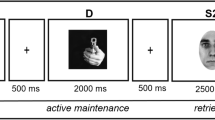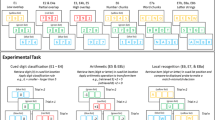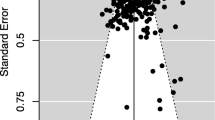Abstract
Previous studies claimed that task representation is carried out by the activated long-term memory portion of working memory (WM; Meiran and Kessler in J Exp Psychol Human Percept Perform 34:137–157, 2008). The present study provides a more direct support for this hypothesis. We used the reaction-time task-rule congruency effect (RT-TRCE) in a task-switching setup, and tested the effects of loading WM with irrelevant task rules on RT-TRCE. Experiment 1 manipulated WM load in a between-subject design. WM participants performed a color/shape task switching, while having 0, 1 or 3 numerical task rules as WM load. Experiment 2 used a similar load manipulation (1 or 3 rules to load WM) in a within-subject design. Experiment 3 extended these results by loading WM with perceptual tasks that were more similar to the shape/color tasks. The results show that RT-TRCE was not affected by WM load supporting the activated long-term memory hypothesis.

Similar content being viewed by others
References
Allport, A., Styles, E. A., & Hsieh, S. (1994). Shifting intentional set: Exploring the dynamic control of tasks. In C. Umilta, & M. Moscovitch (Eds.) Attention and performance XV (pp. 421–452). Hillsdale, NJ: Erlbaum.
Altmann, E. M., & Gray, W. D. (2008). An integrated model of cognitive control in task switching. Psychological Review, 115, 602–639.
Baddeley, A., Chincotta, D., & Adlam, A. (2001). Working memory and the control of action: evidence from task switching. Journal of Experimental Psychology: General, 130, 641–657.
Baddeley, A. D., & Hitch, G. (1974). Working memory. In G. H. Bower (Ed.), Recent advances in learning and motivation, Vol. 8 (pp. 47–90). New York: Academic Press.
Bryck, R. L., & Mayr, U. (2005). On the role of verbalization during task set selection: Switching or serial order control? Memory & Cognition, 33, 611–623.
Cohen-Kdoshay, O., & Meiran, N. (2007). The representation of instructions in working memory leads to autonomous response activation: Evidence from the first trials in the flanker paradigm. Quarterly Journal of Experimental Psychology, 60:1140–1154
Cohen-Kdoshay, O., & Meiran, N. (2009). The representation of instructions operates like a prepared reflex: Flanker compatibility effects that are found in the first trial following S–R instructions. Experimental Psychology, 56, 128–133.
Cowan, N. (1988). Evolving conceptions of memory storage, selective attention, and their mutual constraints within the human information-processing system. Psychological Bulletin, 104, 163–191.
Cowan, N. (1999). An embedded-processes model of working memory. In A. Miyake & P. Shah (Eds.), Models of working memory: Mechanisms of active maintenance and executive control. New York: Cambridge University Press.
Duncan, J., Parr, A., Woolgar, A., Thompson, R., Bright, P., Cox, S., et al. (2008). Goal neglect and Spearman’s g: Competing parts of a complex task. Journal of Experimental Psychology: General, 137, 131–148.
Ellenbogen, R., & Meiran, N. (2008). Working memory involvement in dual task performance: Evidence from the backward compatibility effect. Memory & Cognition, 36, 968–978.
Emerson, M. J., & Miyake, A. (2003). The role of inner speech in task switching: A dual-task investigation. Journal of Memory and Language, 48, 148–168.
Eriksen, B., & Eriksen, C. (1974). Effects of noise letters upon the identification of a target letter in a nonsearch task. Perception & Psychophysics, 16, 143–149.
Goschke, T. (2000). Intentional reconfiguration and involuntary persistence in task-set switching. In S. Monsell & J. Driver (Eds.), Attention and performance XVIII: Control of cognitive processes (pp. 331–355). Cambridge, MA: MIT Press.
Hommel, B. (1998). Automatic stimulus-response translation in dual-task performance. Journal of Experimental Psychology: Human Perception and Performance, 24, 1368–1384.
Hommel, B., & Eglau, B. (2002). Control of stimulus–response translation in dual-task performance. Psychological Research, 66, 260–273.
Kiesel, A., Wendt, M., & Peters, A. (2007). Task switching: On the origins of response congruency effects. Psychological Research, 71, 117–125.
Liefooghe, B., Barrouillet, P., Vandierendonck, A., & Camos, V. (2008). Working memory costs of task switching. Journal of Experimental Psychology: Learning, Memory, and Cognition, 34, 478–494.
Logan, G. D. (2004). Working memory, task switching, and executive control in the task span procedure. Journal of Experimental Psychology: General, 133, 218–236.
Mayr, U., & Keele, S. W. (2000). Changing internal constraints on action: The role of backward inhibition. Journal of Experimental Psychology: General, 129, 4–26.
Mayr, U., & Kliegl, R. (2000). Task-set switching and long-term memory retrieval. Journal of Experimental Psychology: Learning, Memory, and Cognition, 26, 1124–1140.
Meiran, N. (1996). Reconfiguration of processing mode prior to task performance. Journal of Experimental Psychology: Learning, Memory, and Cognition, 22, 1423–1442.
Meiran, N., & Daichman, A. (2005). Advance task preparation reduces task error rate in the cueing task-switching paradigm. Memory and Cognition, 33, 1272–1288.
Meiran, N., & Kessler, Y. (2008). The task rule congruency effect in task switching reflects activated long-term memory. Journal of Experimental Psychology: Human Perception and Performance, 34, 137–157.
Meiran, N., Kessler, Y., & Adi-Japha, E. (2008). Control by action representation and input selection (CARIS): A theoretical framework for task switching. Psychological Research, 72, 473–500.
Miyake, A., Emerson, M. J., Padilla, F., & Ahn, J. (2004). Inner speech as a retrieval aid for task goals: The effects of cue type and articulatory suppression in the random task cuing paradigm. Acta Psychologica, 115, 123–142.
Miyake, A., & Shah, P. (1999). Models of working memory: Mechanisms of active maintenance and executive control. New York: Cambridge University Press.
Oberauer, K. (2001). Removing irrelevant information from working memory: A cognitive aging study with the modified Sternberg task. Journal of Experimental Psychology: Learning, Memory, and Cognition, 27, 948–957.
Oberauer, K. (2002). Access to information in working memory: Exploring the focus of attention. Journal of Experimental Psychology: Learning, Memory, and Cognition, 28, 411–421.
Oberauer, K. (2009). Design for a working memory. The Psychology of Learning and Motivation, 51:45–100
Rubinstein, J. S., Meyer, D. E., & Evans, J. E. (2001). Executive control of cognitive processes in task switching. Journal of Experimental Psychology: Human Perception and Performance, 27, 763–797.
Saeki, E., & Saito, S. (2004). Effect of articulatory suppression on task-switching performance: Implications for models of working memory. Memory, 12, 257–271.
Schneider, W., Eschman, A., & Zuccolotto, A. (2002). E-Prime User’s Guide. Pittsburgh: Psychology Software Tools.
Verhaeghen, P., Cerella, J., & Basak, C. (2004). A working memory workout: How to expand the focus of attention from one to four items in 10 hours or less. Journal of Experimental Psychology: Learning, Memory, and Cognition, 30, 1322–1337.
Waszak, F., Wenke, D., & Brass, M. (2008). Crosstalk of instructed and applied arbitrary visuomotor mappings. Acta Psychologica, 127, 30–35.
Wendt, M., & Kiesel, A. (2008). The impact of stimulus-specific practice and task instructions on response congruency effects between tasks. Psychological Research, 72, 425–432.
Woltz, D. J., & Was, C. A. (2007). Available but unattended conceptual information in working memory: Temporarily active semantic content or persistent memory for prior operations? Journal of Experimental Psychology: Learning, Memory, and Cognition, 33, 155–168.
Yehene, E., Meiran, N., & Soroker, N. (2005). Task alternation cost without task alternation: Measuring intentionality. Neuropsychologia, 43, 1858–1869.
Acknowledgments
The research was supported by a Grant to the second author from the Israel Science Foundation. We thank Shirley Dorchin, Ami Braverman and Iddo Maayan for running Experiments 1 and 2 and Anat Karmon for running Experiment 3.
Author information
Authors and Affiliations
Corresponding author
Appendix
Rights and permissions
About this article
Cite this article
Kessler, Y., Meiran, N. The reaction-time task-rule congruency effect is not affected by working memory load: further support for the activated long-term memory hypothesis. Psychological Research 74, 388–399 (2010). https://doi.org/10.1007/s00426-009-0261-z
Received:
Accepted:
Published:
Issue Date:
DOI: https://doi.org/10.1007/s00426-009-0261-z




